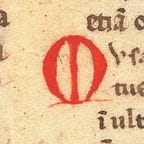A cosmological page of the Visconti Hours
The Visconti Hours manuscript was initially commissioned by Gian Galeazzo Visconti (d. 1402) and later by his son Filippo Maria (d. 1447).
This page (f37v) was painted by Belbello da Pavia in 1440 ca. The text corresponds to the beginning of a hymn derived from Psalm 69 (70): “Deus in adiutorium meum intende Domine ad adiuvandum me festina” — O God, come to my assistance; O Lord, make haste to help me.
The round shape of the initial D provides the basis for a complex cosmograph, i.e. a diagram of the universe. God the Father, surrounded by a cloud of pink cherubs, dominates the whole composition.
A black circle at the centre of the page represents Earth; this is surrounded by a green circular ocean (the Water element); a third circle of blue, white and golden clouds represents Air. A series of thin golden rays pointing to the centre of the diagram corresponds to the sphere of Fire.
The shape of letter D is rendered as a complex Gothic architecture painted in pink. On the left and right sides, the Visconti’s heraldic dove is represented. The sun at the top fulfils a double function: the radiant sun is another of the symbols of the Visconti family; the sun here also represents one of the two “luminaries” — the moon appears on the opposite point of the circle.
The outer circle illustrates the sphere of the fixed stars: the twelve zodiac signs, intermixed with golden semicircles on a blue background.
While the Sun and the Moon are incorporated in the central circular diagram, the other five planets of classical astronomy appear as personifications on the left. From the top to the bottom:
Saturn — an old man with a scythe wearing a military helmet
Jupiter — a haloed figure with emblems of temporal and spiritual power (the sceptre and the pastoral)
Mars — wearing a green armour and overloaded with all kinds of weapons
Venus — a young woman in a blue dress
Mercury — a haloed bishop-like figure holding the caduceus and a book
Finally, the page includes personifications of the four seasons. Following the genre of Italian and Latin words, Spring and Summer are represented as women, Autumn and Winter as men.
Spring appears in the right margin, as a woman in a green top and red gown. She seems to be sitting in a large nest. Spring holds in each hand a flowering branch.
Summer is represented below Spring. Her figures echoes that of Venus, on the opposite side of the page: a lady in blue holding a plant with blue flowers.
In the lower margin, Autumn is represented as a bearded man gathering grapes.
Winter is an old man warming himself near a fire.
